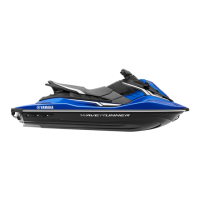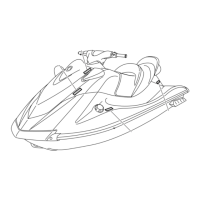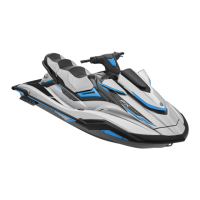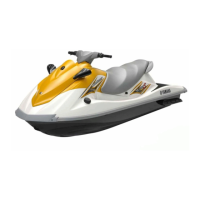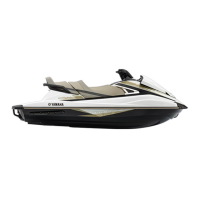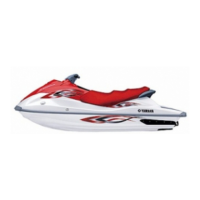Do you have a question about the Yamaha WaveRunner VX Deluxe 2007 and is the answer not in the manual?
Details conformity of PWC with EU directives, including manufacturer and representative information.
Lists conformity modules and identification details for craft and engine as per declaration.
Welcome message, manual usage guidance, and explanations of CAUTION, NOTE, and WARNING symbols.
Explains PRI-ID, HIN, and engine serial number locations and their importance for parts and theft recovery.
Details builder's plate information, location, and wave height notes for European models.
States compliance with Canadian and US EPA emission regulations and approval label location.
Explains the location of the manufactured date label on the cylinder head.
Illustrates and identifies various important safety and identification labels on the watercraft.
Details critical safety warnings regarding PFDs, protective clothing, riding limits, and operating under the influence.
Provides safety warnings in French concerning collisions, gear, and operating under influence.
Warns about gasoline flammability, safe refueling, lifting PWC, water entry, and breather hose connection.
Covers European operational rules, VX Deluxe/Cruiser reverse lever, and other labels.
Notes compliance with Canadian interference regulations and European CE marking.
Indicates the location of the CE marking on the remote control transmitter for European models.
Specifies minimum operator age, supervision, and maximum load/passenger limits for safe operation.
Advises on defensive operation, scanning, safe speeds, and avoiding hazards like shallow water or poor visibility.
Details requirements for PFDs, protective clothing, and eye protection for all riders.
Discusses helmet benefits/hazards and strictly prohibits operating under alcohol or drugs.
Lists essential items to carry onboard, including signaling devices and a towline.
Warns about exhaust fumes and hot parts, explains jet thrust steering and lack of neutral.
Provides warnings for reverse use and keeping clear of intake grates and jet nozzles.
Offers considerations for safe water-skiing, including PFDs and protective gear for skiers.
Emphasizes that the watercraft is a powerboat and must follow waterway regulations.
Promotes respect for others, nature, and proper maintenance for enjoyable waterways.
Identifies key external components of the watercraft using a front view diagram.
Identifies key components located at the rear of the watercraft using a diagram.
Details the main controls found on the handlebars and steering column.
Identifies major components located within the engine compartment.
Instructions for removing/installing the seat and opening/closing the hood.
Instructions for the fuel tank filler cap and information on the remote transmitter for security.
Explains the operation of the engine stop switch and the engine shut-off cord.
Instructions for using the start switch, throttle lever, and checking the cooling outlet.
Explains the steering system, OTS, and the shift lever for VX Deluxe/Cruiser models.
Details handgrips, bow eye, stern eyes, and warnings related to reverse operation.
Overview of YEMS, security system, and lock/unlock modes for VX Deluxe/Cruiser.
Instructions for selecting normal and low-RPM modes using the remote control transmitter.
Explains the multifunction meter, tachometer, speedometer, and fuel level meter.
Describes the fuel level meter, hour meter, voltmeter, and fuel level warning indicator.
Explains oil pressure, engine overheat, and check engine warning indicators.
Explains the function of the "SECURITY" and "L-MODE" indicator lights.
Details the front storage and glove compartments, including their capacities and load limits.
Instructions for opening/closing front and glove compartments, including beverage/transmitter holders.
Reminder to keep the remote control transmitter in its holder when operating the watercraft.
Provides information on the 4-stroke engine, fuel types, and recommended gasoline.
Details engine oil specifications and safe procedures for filling the fuel tank.
A comprehensive checklist of items to inspect before launching or operating the watercraft.
Specific pre-operation checks for engine compartment, hull, fuel system, and multifunction display.
Step-by-step instructions and safety precautions for checking the engine oil level.
Procedures for checking and draining the water separator and bilge.
Instructions for checking stern drain plugs and the battery's condition and connections.
Checks for the fire extinguisher, throttle lever, and steering system operation.
Instructions for checking the shift lever, reverse gate, and jet intake for debris.
Procedures for checking switches, engine shut-off cord, and cooling water outlet.
Checking the multifunction display and the essential engine break-in procedure.
Step-by-step instructions for launching the watercraft and starting the engine.
Emphasizes engine starting safety, throttle lever use, and proper attachment of the shut-off cord.
Instructions for stopping the engine and getting acquainted with watercraft operation.
Advises on defensive riding, use of PFDs, protective clothing, and passenger handling.
Guidelines for boarding with passengers and starting the watercraft, including shallow water procedures.
Instructions for boarding from a dock and boarding the watercraft alone.
Steps for boarding with multiple passengers and maintaining watercraft balance.
Detailed procedures for safely uprighting a capsized watercraft and preventing damage.
Explains how throttle and handlebar input affect watercraft turning and steering response.
Describes how the watercraft stops and emphasizes collision avoidance through adequate stopping distance.
Instructions for safely beaching and docking the watercraft, including approaching speeds.
Advice on operating in rough water and essential post-operation care procedures.
Guidelines for securely transporting the watercraft on a trailer, including tie-down points.
Instructions for storing the watercraft and flushing the cooling system to prevent clogging.
Details lubrication of cables and checking the fuel system for leaks and damage.
Instructions for changing engine oil and replacing the oil filter.
How to check the jet thrust nozzle angle and the shift cable for proper contact.
Instructions for checking/adjusting the throttle cable and cleaning/adjusting spark plugs.
Lists lubrication points and detailed instructions for checking and maintaining the battery.
A chart outlining recommended periodic maintenance tasks based on hours or months of use.
Guidance on using the troubleshooting section and when to consult a dealer.
Lists common problems like irregular engine running, warning lights, and loss of power with causes and remedies.
General emergency advice and detailed steps for cleaning a clogged jet intake or impeller.
Instructions for jump-starting the battery and correctly connecting jumper cables.
Instructions for locating and replacing blown fuses in the electrical box.
Guidelines for towing the watercraft and procedures for a submerged watercraft.
| Manufacturer | Yamaha |
|---|---|
| Model | WaveRunner VX Deluxe |
| Year | 2007 |
| Cylinders | 4 |
| Displacement | 1052 cc |
| Compression Ratio | 11.0:1 |
| Fuel Delivery System | Electronic Fuel Injection (EFI) |
| Starter System | Electric |
| Lubrication System | Wet sump |
| Cooling System | Water-cooled |
| Fuel Type | Regular Unleaded |
| Passenger Capacity | 2 |
| Hull Type | Modified-V |
| Max Horsepower | 110 hp |
| Impeller | 3-blade, stainless steel |
| Throttle System | Electronic |
| Steering System | Handlebar |
| Category | Personal Watercraft |
| Engine Type | 4-stroke |
| Width | 1.22 m |
| Rider Capacity | 3 |
| Beam | 1.22 m |
| Propulsion System | Jet Propulsion |
| Reverse System | Mechanical |
| Instrumentation | Digital |
| Security System | Yamaha Security System |
| Color Options | Blue, Silver |


